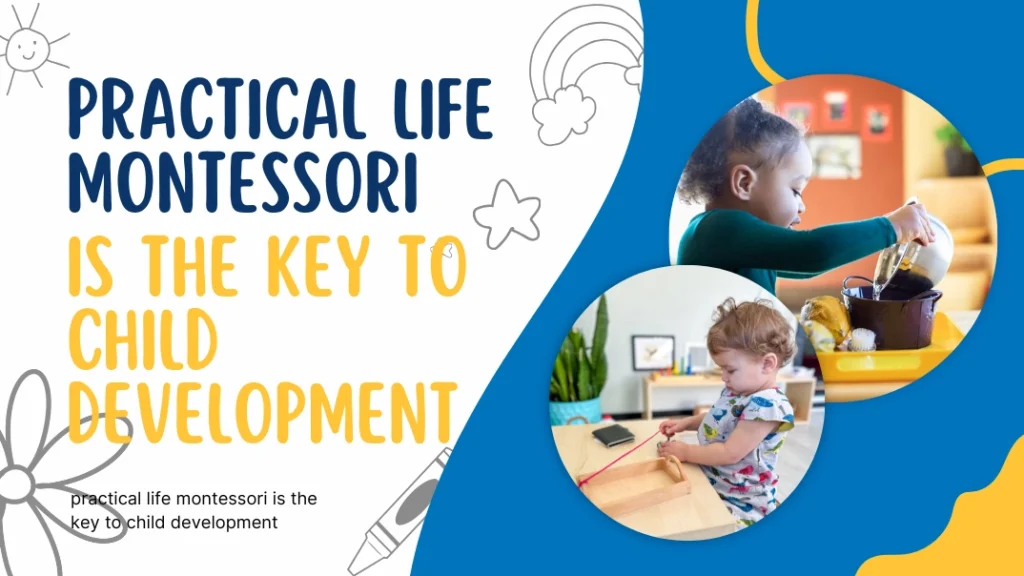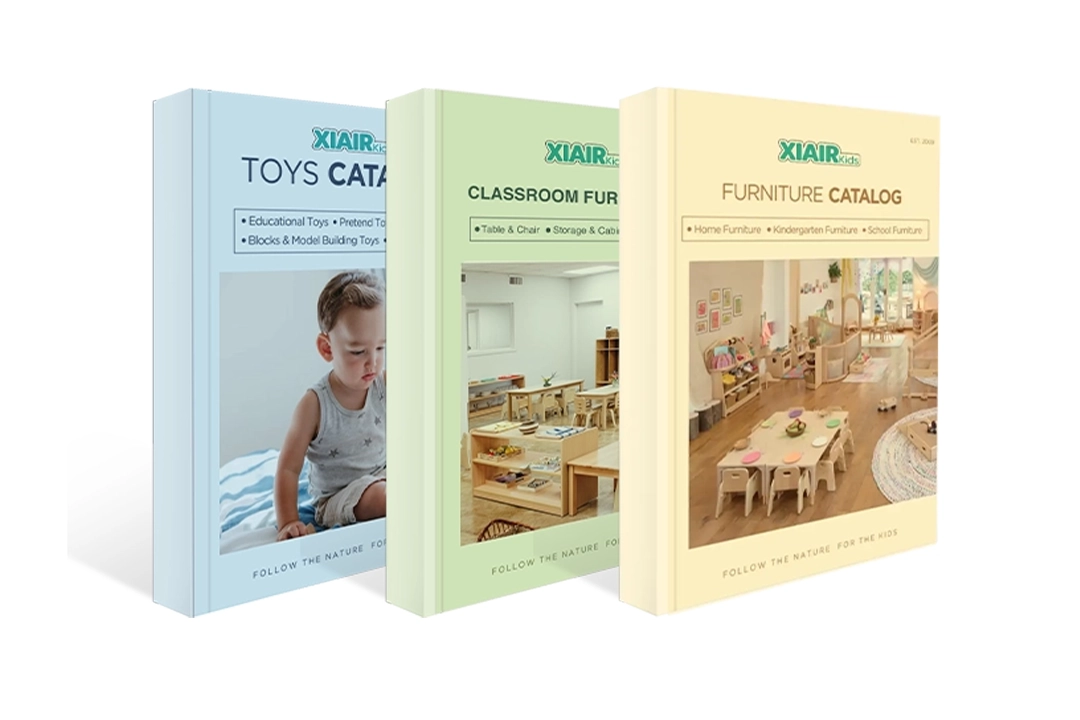พ่อแม่หลายคนสังเกตเห็นว่าลูก ๆ มีปัญหากับงานง่าย ๆ ในชีวิตประจำวัน เช่น การติดกระดุมเสื้อ การรินเครื่องดื่ม หรือการทำความสะอาด โรงเรียนให้ความสำคัญกับวิชาการเป็นอย่างมาก แต่บ่อยครั้งกลับมองข้ามทักษะชีวิตที่จำเป็น หากปราศจากการเรียนรู้แบบลงมือปฏิบัติ เด็กๆ จะพลาดโอกาสพัฒนาทักษะชีวิตจริง ซึ่งนำไปสู่การขาดความมั่นใจและความเป็นอิสระ นี่คือจุดที่กิจกรรม Practical Life Montessori สามารถสร้างความแตกต่างได้
เด็กที่ไม่ได้มีส่วนร่วมในกิจกรรมในชีวิตประจำวันแบบมอนเตสซอรีอาจพึ่งพาผู้ใหญ่มากเกินไป สิ่งเล็กๆ น้อยๆ เช่น การจัดโต๊ะอาหาร การจัดพื้นที่ส่วนตัว หรือการทักทายผู้อื่นอย่างสุภาพ อาจทำให้รู้สึกหนักใจได้ ปัญหานี้ยิ่งเห็นได้ชัดเจนยิ่งขึ้นในเด็กก่อนวัยเรียนและเด็กเล็กในช่วงวัยสำคัญต่อการพัฒนา ทักษะการเคลื่อนไหวที่ดีและการประสานงาน อย่างไรก็ตาม ประสบการณ์ในชีวิตประจำวันเหล่านี้เป็นส่วนหนึ่งของกระบวนการเรียนรู้ในห้องเรียนมอนเตสซอรี กิจกรรมต่างๆ เช่น การริน การกวาด การล้างมือ และการเตรียมอาหาร จะถูกจัดวางบนชั้นกิจกรรมในชีวิตประจำวันของมอนเตสซอรี เพื่อกระตุ้นให้เด็กๆ รับผิดชอบต่อการกระทำของตนเอง
วิธีการแบบมอนเตสซอรีออกแบบมาเพื่อช่วยให้เด็กๆ เรียนรู้ผ่านประสบการณ์จริง โดยใช้สื่อการเรียนรู้แบบมอนเตสซอรี เด็กๆ จะได้ฝึกฝนแบบฝึกหัดที่มีโครงสร้างชัดเจนเพื่อพัฒนาทักษะของพวกเขา การดูแลตนเองการดูแลสิ่งแวดล้อม ความสง่างามและความสุภาพ และการควบคุมการเคลื่อนไหว คือหัวใจสำคัญสี่ประการของการใช้ชีวิตแบบมอนเตสซอรี กิจกรรมเหล่านี้ไม่เพียงแต่ช่วยให้เด็กมีกิจกรรมทำเท่านั้น แต่ยังออกแบบมาเพื่อเสริมสร้างสมาธิ ความเป็นอิสระ และทักษะการแก้ปัญหา ไม่ว่าจะอยู่ที่บ้านหรือในห้องเรียนแบบมอนเตสซอรี บทเรียนเหล่านี้จะช่วยเตรียมความพร้อมให้เด็กๆ ประสบความสำเร็จทั้งในโรงเรียนและในชีวิตจริง
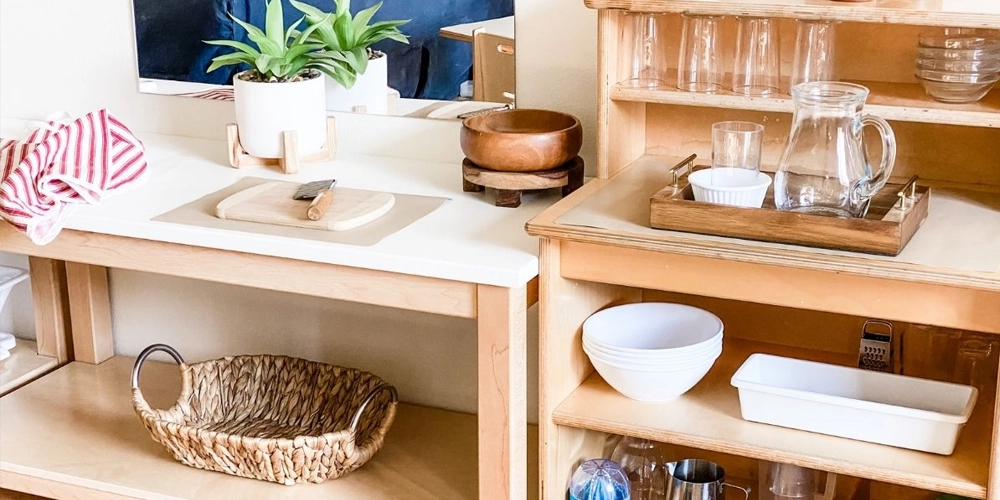
ชีวิตจริงในมอนเตสซอรีคืออะไร?
การใช้ชีวิตจริง มอนเตสซอรีเป็นส่วนสำคัญของวิธีการสอนแบบมอนเตสซอรี โดยเน้นกิจกรรมในชีวิตจริงที่ช่วยให้เด็กพัฒนาความเป็นอิสระ สมาธิ การประสานงาน และความรับผิดชอบ กิจกรรมเหล่านี้ประกอบด้วยงานง่ายๆ เช่น การติดกระดุมเสื้อ การเทน้ำ การกวาดพื้น และการจัดโต๊ะอาหาร กิจกรรมเหล่านี้ช่วยให้เด็กได้มีส่วนร่วมในชีวิตประจำวัน ช่วยเสริมสร้างความมั่นใจและทักษะการปฏิบัติ
ดร. มาเรีย มอนเตสซอรี สังเกตว่าเด็กๆ ชอบเลียนแบบผู้ใหญ่และมักถูกดึงดูดให้ทำสิ่งที่มีความหมายโดยธรรมชาติ แทนที่จะมองเด็กๆ เป็นเพียงผู้เรียนแบบเฉื่อยๆ กิจกรรมชีวิตจริงของมอนเตสซอรีจะมอบประสบการณ์ตรงที่เตรียมความพร้อมให้พวกเขาสำหรับความท้าทายในโลกแห่งความเป็นจริง ในห้องเรียนแบบมอนเตสซอรี อุปกรณ์ชีวิตจริงจะถูกจัดเรียงอย่างเป็นระเบียบบนชั้นวางกิจกรรมชีวิตจริงของมอนเตสซอรี ช่วยให้เด็กๆ เลือกกิจกรรมได้อย่างอิสระ ผู้ปกครองสามารถสร้างกิจกรรมชีวิตจริงแบบมอนเตสซอรีที่บ้านได้โดยการเปิดโอกาสให้บุตรหลานได้มีส่วนร่วมในงานบ้านประจำวัน
คุณสมบัติหลักของชีวิตจริงแบบมอนเตสซอรี่
✔️ การเรียนรู้แบบปฏิบัติจริง – เด็กๆ มีส่วนร่วมอย่างกระตือรือร้นในงานในชีวิตจริง
✔️ ส่งเสริมความเป็นอิสระ – เด็กๆ เรียนรู้ที่จะดูแลตัวเองและสิ่งแวดล้อมรอบตัว
✔️ พัฒนาทักษะการเคลื่อนไหวที่ดี – กิจกรรมต่างๆ ช่วยเสริมสร้างความแข็งแรงและการประสานงานของมือ
✔️ สร้างสมาธิและความอดทน – การเคลื่อนไหวซ้ำๆ ช่วยให้เด็กมีสมาธิมากขึ้น
✔️ เตรียมความพร้อมสำหรับการเรียนรู้ในอนาคต – งานปฏิบัติจริงสร้างความมั่นใจและทักษะในการแก้ไขปัญหา
ตัวอย่าง: ในห้องเรียนแบบมอนเตสซอรี เด็ก ๆ อาจได้ฝึกฝนกิจกรรมในชีวิตประจำวันแบบมอนเตสซอรี เช่น การย้ายเมล็ดพืชด้วยช้อน กิจกรรมง่าย ๆ นี้จะช่วยเสริมสร้างทักษะการเคลื่อนไหวกล้ามเนื้อมัดเล็ก และสอนความแม่นยำ ความอดทน และการควบคุม ซึ่งล้วนจำเป็นสำหรับการเขียนและการทำงานประจำวัน
ความสำคัญของการใช้ชีวิตจริงในหลักสูตรมอนเตสซอรี
พ่อแม่หลายคนตั้งคำถามว่า: การใช้ชีวิตจริงในหลักสูตรมอนเตสซอรีมีความสำคัญอย่างไร? คำตอบนั้นง่ายมาก นั่นคือ ช่วยให้เด็กๆ พัฒนาทักษะที่พวกเขาจะนำไปใช้ได้ตลอดชีวิต ต่างจากการศึกษาแบบดั้งเดิมที่เน้นด้านวิชาการเป็นหลัก กิจกรรมการใช้ชีวิตจริงของมอนเตสซอรีช่วยให้เด็กๆ ได้ฝึกฝนทักษะสำคัญๆ เช่น การดูแลตนเอง มารยาททางสังคม การแก้ปัญหา และการประสานงาน
เมื่อเด็กๆ ได้มีส่วนร่วมในกิจกรรม Montessori ในชีวิตประจำวัน พวกเขาจะมีความรู้สึกถึงจุดมุ่งหมายในชีวิต ความเป็นอิสระ และวินัยในตนเอง ทักษะเหล่านี้จะสร้างรากฐานที่แข็งแกร่งสำหรับการเรียนรู้เชิงวิชาการ เพราะเด็กๆ ที่มีสมาธิจดจ่อ ปฏิบัติตามขั้นตอน และมีความรับผิดชอบ จะสามารถเตรียมความพร้อมสำหรับบทเรียนคณิตศาสตร์ การอ่าน และวิทยาศาสตร์ที่มีโครงสร้างชัดเจนได้ดีขึ้น
ปรัชญาและเป้าหมายโดยตรงของการใช้ชีวิตแบบมอนเตสซอรี
ดร. มาเรีย มอนเตสซอรี เชื่อว่าเด็กๆ จะเรียนรู้ได้ดีที่สุดผ่านประสบการณ์ตรง เธอเห็นว่าเมื่อเด็กๆ ได้รับมอบหมายงานจริง พวกเขาก็จะพัฒนาความรู้สึกถึงจุดมุ่งหมาย ความเป็นอิสระ และความรับผิดชอบ แนวคิดนี้เป็นหัวใจสำคัญของกิจกรรมในชีวิตประจำวันของมอนเตสซอรี คือการมอบเครื่องมือและความรับผิดชอบพื้นฐานให้กับเด็กๆ แทนที่จะมอบของเล่นหรือการเล่นสมมติ
แบบฝึกหัดปฏิบัติจริงในห้องเรียนมอนเตสซอรีได้รับการคัดสรรมาอย่างดีเพื่อช่วยให้เด็กๆ พัฒนาทักษะพื้นฐาน กิจกรรมเหล่านี้มักจัดวางบนถาดฝึกปฏิบัติจริงของมอนเตสซอรี ช่วยให้เด็กๆ ได้ฝึกฝนทักษะในชีวิตประจำวันอย่างมีระเบียบแบบแผนและควบคุมได้
จุดมุ่งหมายโดยตรงและโดยอ้อมของการใช้ชีวิตแบบมอนเตสซอรี
| ประเภทของเป้าหมาย | วัตถุประสงค์ | ตัวอย่าง |
|---|---|---|
| จุดมุ่งหมายโดยตรง | ช่วยให้เด็กพัฒนาทักษะเฉพาะ เช่น การประสานงาน ความเป็นอิสระ และความรับผิดชอบ | การเท การตัก การกวาด การพับผ้า |
| จุดมุ่งหมายทางอ้อม | เตรียมเด็กๆ สำหรับการเรียนรู้ในอนาคตโดยการปรับปรุงสมาธิ การแก้ปัญหา และความอดทน | การร้อยลูกปัด (เตรียมเขียน) การจัดเรียงวัตถุ (เตรียมคณิตศาสตร์) |
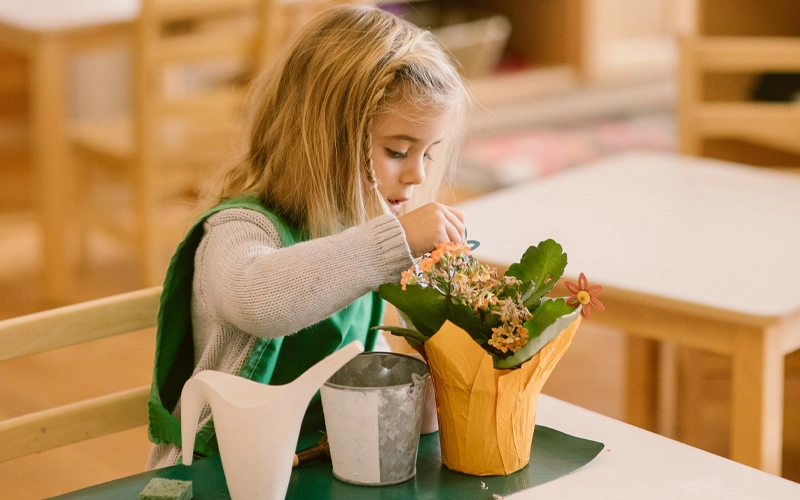
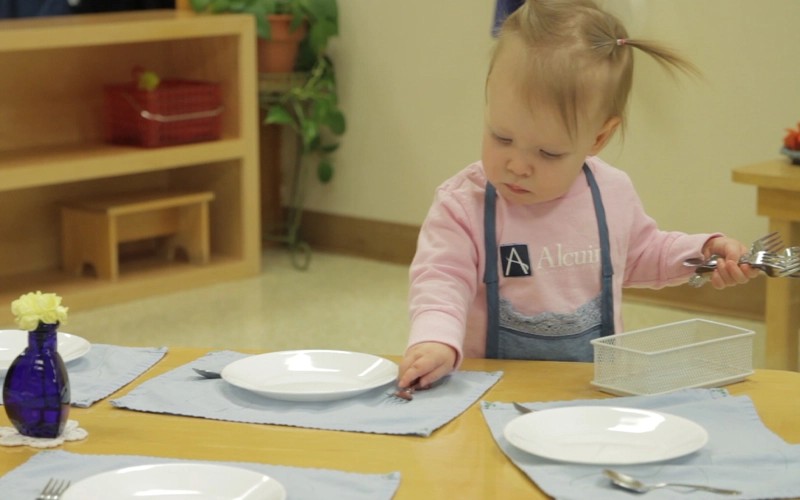
4 ด้านของชีวิตจริงแบบมอนเตสซอรี
กิจกรรมการใช้ชีวิตจริงของมอนเตสซอรีแบ่งออกเป็น 4 ส่วนหลัก แต่ละส่วนออกแบบมาเพื่อช่วยให้เด็กพัฒนาความเป็นอิสระ การประสานงาน สมาธิ และความรับผิดชอบ ครอบคลุมการดูแลตนเอง การดูแลสภาพแวดล้อม ปฏิสัมพันธ์ทางสังคม และการควบคุมการเคลื่อนไหว เพื่อให้มั่นใจว่าเด็ก ๆ จะได้รับทักษะชีวิตที่จำเป็น
การดูแลตัวเอง
หัวข้อนี้มุ่งเน้นที่การช่วยให้เด็กๆ มีอิสระในการดำเนินชีวิต กิจกรรมต่างๆ เช่น การล้างมือ แปรงฟัน แต่งตัว และผูกเชือกรองเท้า ช่วยให้เด็กๆ มีความรับผิดชอบต่อความต้องการของตนเอง เด็กๆ พัฒนาทักษะการเคลื่อนไหว ความอดทน และความมั่นใจผ่านแบบฝึกหัดชีวิตจริงแบบมอนเตสซอรีเหล่านี้ ไม่ว่าจะอยู่ในห้องเรียนแบบมอนเตสซอรีหรือที่บ้าน การจัดหาอุปกรณ์ขนาดเล็กและกิจวัตรประจำวันที่เป็นระบบจะช่วยส่งเสริมการดูแลตนเองและความสามารถในการพึ่งพาตนเอง
ตัวอย่างกิจกรรมการใช้ชีวิตแบบมอนเตสซอรี (การดูแลตนเอง)
| กิจกรรม | พัฒนาฝีมือ | กลุ่มอายุมอนเตสซอรี |
|---|---|---|
| การแปรงผม | การควบคุมมือ การดูแลตนเอง | อายุ 2-3 ปี |
| การล้างมือ | สุขอนามัย การสร้างกิจวัตรประจำวัน | อายุ 2-4 ปี |
| การติดกระดุมและซิป | การประสานงานกล้ามเนื้อมัดเล็ก | อายุ 3-5 ปี |
| การผูกเชือกรองเท้า | การแก้ไขปัญหา ความอดทน | อายุ 4-6 ปี |
| การเตรียมอาหารว่าง | ความเป็นอิสระ, การเรียงลำดับ | อายุ 3-6 ปี |
ตัวอย่าง: ในกิจกรรมฝึกปฏิบัติในชีวิตประจำวันของเด็กเล็กแบบมอนเตสซอรี เด็กอายุ 2 ขวบอาจฝึกล้างมือที่อ่างล้างมือแบบมอนเตสซอรีที่มีอ่างล้างมือเตี้ย กิจกรรมง่ายๆ นี้จะช่วยสอนเรื่องสุขอนามัย กิจวัตรประจำวัน และการดูแลตัวเอง พร้อมทั้งช่วยพัฒนาทักษะการประสานงานของมือด้วย
วิธีจัดกิจกรรมดูแลตนเองที่บ้าน
- จัดเตรียมอุปกรณ์ขนาดเด็ก (แปรงขนาดเล็ก ปุ่มใช้งานง่าย)
- สร้างพื้นที่แต่งตัวที่ต่ำเพื่อให้เด็กๆ สามารถเข้าถึงเสื้อผ้าของตัวเองได้
- ส่งเสริมให้เด็กๆ ช่วยเตรียมอาหารง่ายๆ เช่น ปอกกล้วยหรือทาเนยบนขนมปังปิ้ง
การดูแลสิ่งแวดล้อม
ในกิจกรรมชีวิตจริงแบบมอนเตสซอรี เด็กๆ จะได้เรียนรู้ถึงความสำคัญของการดูแลสิ่งแวดล้อมรอบตัว ส่งเสริมความรับผิดชอบและความเป็นระเบียบเรียบร้อย กิจกรรมต่างๆ เช่น การกวาดบ้าน เช็ดโต๊ะ รดน้ำต้นไม้ และจัดวางชั้นวางของ ล้วนสอนให้เด็กๆ รู้จักรักษาความสะอาด ชื่นชมธรรมชาติ และมีส่วนร่วมในการดูแลสิ่งแวดล้อม กิจกรรมเหล่านี้มักพบในกิจกรรมชีวิตจริงแบบมอนเตสซอรี ซึ่งเด็กๆ สามารถเลือกแบบฝึกหัดที่ส่งเสริมการคิดเชิงตรรกะและการประสานงานได้อย่างอิสระ
ตัวอย่างแบบฝึกหัดการใช้ชีวิตแบบมอนเตสซอรี่ (การดูแลสิ่งแวดล้อม)
| กิจกรรม | พัฒนาฝีมือ | กลุ่มอายุมอนเตสซอรี |
|---|---|---|
| การกวาดพื้น | ทักษะการเคลื่อนไหวร่างกายโดยรวม ความรับผิดชอบ | อายุ 2-4 ปี |
| การเช็ดโต๊ะ | สมาธิ ทักษะการทำความสะอาด | อายุ 2-5 ปี |
| การรดน้ำต้นไม้ | การดูแล ความอดทน | อายุ 3-6 ปี |
| การจัดระเบียบชั้นวาง | การคิดเชิงตรรกะ ความเป็นระเบียบ | อายุ 3-6 ปี |
| การพับผ้า | การเรียงลำดับ ทักษะการเคลื่อนไหวที่ดี | อายุ 4-6 ปี |
ตัวอย่าง: เด็กอายุ 4 ขวบในห้องเรียนมอนเตสซอรีอาจได้ทำกิจกรรมในชีวิตประจำวันจริง ๆ หลังเลิกเรียน กิจกรรมนี้ช่วยสอนให้พวกเขามีความรับผิดชอบ รู้จักการประสานงาน และการพึ่งพาตนเอง พร้อมกับทำให้พวกเขารู้สึกเหมือนเป็นส่วนหนึ่งของสภาพแวดล้อมที่เอื้อเฟื้อ
วิธีจัดกิจกรรมดูแลสิ่งแวดล้อมที่บ้าน
- จัดเตรียมสถานีทำความสะอาดขนาดเด็กพร้อมด้วยไม้กวาดขนาดเล็ก ที่โกยผง และขวดสเปรย์
- ส่งเสริมให้เด็กๆ ให้อาหารสัตว์เลี้ยง รดน้ำต้นไม้ และเช็ดพื้นผิว
- ใช้ถาดอเนกประสงค์ของ Montessori เพื่อจัดระเบียบวัสดุต่างๆ และสอนให้เด็กๆ รักษาความเป็นระเบียบในพื้นที่ของตน

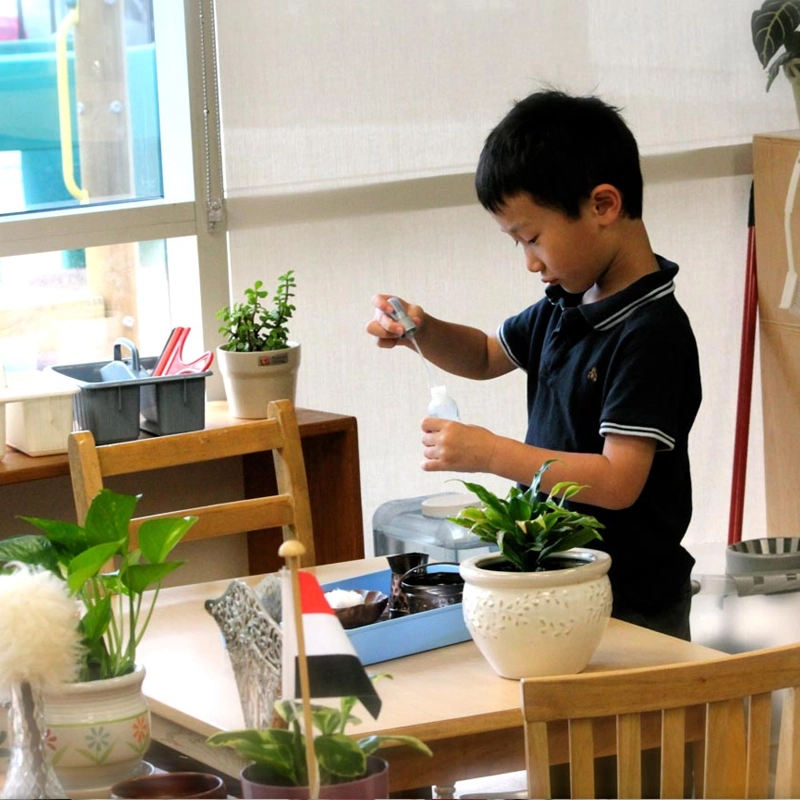
ความสง่างามและความสุภาพ
การศึกษาแบบมอนเตสซอรีเน้นย้ำทักษะทางสังคม ความเคารพ และความเห็นอกเห็นใจ ทำให้ความสง่างามและความสุภาพเป็นสิ่งสำคัญยิ่งต่อกิจกรรมในชีวิตจริง เด็กๆ ฝึกการทักทายผู้อื่น การใช้ถ้อยคำสุภาพ การรอคอย และการแสดงความเมตตา ซึ่งช่วยเสริมสร้างความมั่นใจและสติปัญญาทางอารมณ์ กิจกรรมตามฤดูกาล เช่น แบบฝึกหัดชีวิตจริงในวันขอบคุณพระเจ้าของมอนเตสซอรี สามารถเสริมสร้างบทเรียนเหล่านี้ได้ด้วยการสอนความกตัญญูและการมีน้ำใจในสถานการณ์จริง
ตัวอย่างกิจกรรมปฏิบัติจริงของ Montessori (ความสง่างามและความสุภาพ)
| กิจกรรม | พัฒนาฝีมือ | กลุ่มอายุมอนเตสซอรี |
|---|---|---|
| การทักทายผู้อื่น | การสื่อสาร ความมั่นใจ | อายุ 2-4 ปี |
| การพูดว่า “กรุณา” และ “ขอบคุณ” | มารยาททางสังคม | อายุ 2-5 ปี |
| การผลัดกันสนทนา | ทักษะการฟัง | อายุ 3-6 ปี |
| การเปิดประตูให้คนอื่น | ความตระหนักรู้ ความกรุณา | อายุ 3-6 ปี |
| การเขียนบันทึกขอบคุณ | ความกตัญญู ทักษะการเคลื่อนไหวที่ดี | อายุ 4-6 ปี |
ตัวอย่าง: ในช่วงกิจกรรมวันขอบคุณพระเจ้าของ Montessori เด็กๆ จะได้ฝึกแสดงความขอบคุณด้วยการเขียนโน้ตขอบคุณง่ายๆ หรือจัดโต๊ะอาหารร่วมกัน ซึ่งจะช่วยสร้างความเห็นอกเห็นใจและตระหนักรู้ในสังคม
วิธีส่งเสริมความสง่างามและความสุภาพที่บ้าน
- เป็นแบบอย่างของความสุภาพและพฤติกรรมที่เคารพผู้อื่นในการปฏิสัมพันธ์ในชีวิตประจำวัน
- สร้างโอกาสให้เด็กได้ฝึกการทักทายแขก
- ส่งเสริมการผลัดกันพูดคุยระหว่างครอบครัว
การควบคุมการเคลื่อนไหว
การประสานงานทางกายภาพเป็นสิ่งจำเป็นต่อพัฒนาการด้านกล้ามเนื้อมัดเล็ก การทรงตัว และการรับรู้ร่างกายโดยรวม แบบฝึกหัดชีวิตจริงของมอนเตสซอรีในส่วนนี้ประกอบด้วยการเดินอย่างระมัดระวังขณะถือสิ่งของ การเทน้ำโดยไม่หก การใช้แหนบเพื่อย้ายสิ่งของ และการร้อยลูกปัด กิจกรรมเหล่านี้ช่วยพัฒนาทักษะการประสานงานระหว่างมือและตาและการโฟกัส เตรียมความพร้อมให้เด็กสำหรับกิจกรรมต่างๆ เช่น การเขียนและการดูแลตนเอง ยกตัวอย่างเช่น ในกิจกรรมชีวิตจริงช่วงฤดูหนาวของมอนเตสซอรี เด็กๆ อาจมีส่วนร่วมในแบบฝึกหัดการทรงตัวที่ช่วยเพิ่มความมั่นคงและการควบคุม
ตัวอย่างแบบฝึกหัดการใช้ชีวิตแบบมอนเตสซอรี่ (การควบคุมการเคลื่อนไหว)
| กิจกรรม | พัฒนาฝีมือ | กลุ่มอายุมอนเตสซอรี |
|---|---|---|
| การเดินบนเส้น | ความสมดุล โฟกัส | อายุ 2-4 ปี |
| การขนย้ายสิ่งของด้วยความระมัดระวัง | การประสานงาน,การควบคุม | อายุ 2-5 ปี |
| เทโดยไม่หก | การควบคุมกล้ามเนื้อมัดเล็ก | อายุ 3-6 ปี |
| การใช้แหนบเพื่อถ่ายโอนวัตถุ | ความแข็งแรงของมือ ความแม่นยำ | อายุ 3-6 ปี |
| การร้อยลูกปัด | การประสานงานระหว่างมือและตา | อายุ 4-6 ปี |
ตัวอย่าง: ในกิจกรรมชีวิตจริงช่วงฤดูหนาวของ Montessori เด็กๆ อาจเดินอย่างระมัดระวังในขณะที่ทรงตัววัตถุเล็กๆ บนช้อน ซึ่งจะช่วยให้พวกเขาพัฒนาสมาธิและการเคลื่อนไหวที่มั่นคง
วิธีส่งเสริมการควบคุมการเคลื่อนไหวที่บ้าน
- ตั้งเส้นทางเดินโดยใช้เทปติดบนพื้นเพื่อใช้ในการฝึกทรงตัว
- จัดเตรียมเหยือกน้ำขนาดเด็กไว้สำหรับเทน้ำ
- รวมถาดฝึกทักษะการใช้ชีวิตประจำวันแบบมอนเตสซอรี่พร้อมแหนบและวัตถุขนาดเล็กเพื่อฝึกฝนทักษะการเคลื่อนไหวที่ดี
โดยการมีส่วนร่วมในสี่ด้านของการใช้ชีวิตแบบมอนเตสซอรีในทางปฏิบัตินี้ เด็กๆ จะได้รับการพัฒนาทักษะที่จำเป็นสำหรับชีวิตประจำวัน ได้รับความเป็นอิสระ ความมั่นใจ และความรู้สึกถึงความรับผิดชอบ ซึ่งจะเป็นประโยชน์ต่อพวกเขาตลอดการศึกษาและต่อๆ ไป
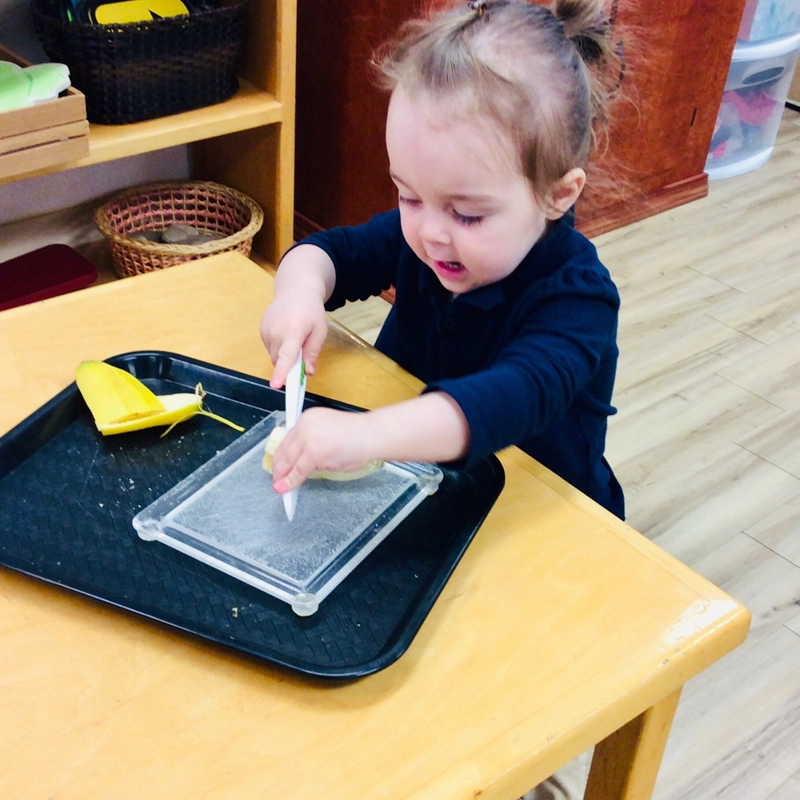

ลำดับและโครงสร้างของกิจกรรมชีวิตจริงแบบมอนเตสซอรี
ลำดับการใช้ชีวิตจริงในมอนเตสซอรี่เป็นอย่างไร?
ลำดับกิจกรรมการใช้ชีวิตจริงแบบมอนเตสซอรี่ดำเนินไปอย่างมีตรรกะ ซึ่งช่วยให้เด็กๆ พัฒนาความเป็นอิสระ การประสานงาน และความรับผิดชอบได้ตามจังหวะของตนเอง ห้องเรียนมอนเตสซอรี่ได้รับการออกแบบอย่างพิถีพิถัน เพื่อให้เด็กๆ พัฒนาจากงานง่ายๆ ไปสู่งานที่ซับซ้อนมากขึ้น เพื่อให้แน่ใจว่าเด็กๆ เชี่ยวชาญก่อนจะพัฒนาต่อไป
ลำดับทั่วไปของกิจกรรมชีวิตเชิงปฏิบัติของ Montessori:
- ทักษะการเคลื่อนไหวขั้นพื้นฐาน – การเท การตัก การเคลื่อนย้ายวัตถุ
- กิจกรรมการดูแลตนเอง – การแต่งตัว การล้างมือ การหวีผม
- การดูแลสิ่งแวดล้อม – กวาด เช็ดโต๊ะ รดน้ำต้นไม้
- ทักษะทางสังคม (ความสง่างามและความสุภาพ) – การทักทายโดยกล่าวว่า “โปรด” และ “ขอบคุณ”
- กิจกรรมการประสานงานขั้นสูง – การร้อยลูกปัด, การใช้คีม, การผูกเชือกรองเท้า
ลำดับขั้นตอนนี้ช่วยให้เด็กๆ พัฒนาทักษะการเคลื่อนไหว การคิดเชิงตรรกะ และความมั่นใจในการจัดการกับงานประจำวัน หลักสูตรชีวิตจริงแบบมอนเตสซอรีที่มีโครงสร้างที่ดีจะช่วยให้เด็กแต่ละคนเรียนรู้ตามจังหวะของตนเอง และค่อยๆ เพิ่มระดับความรับผิดชอบของตนเอง
จะสร้างโครงสร้างชั้นวางชีวิตประจำวันแบบ Montessori Practical Life Shelf ได้อย่างไร?
ชั้นวางหนังสือแบบมอนเตสซอรี่สำหรับชีวิตจริงได้รับการจัดวางอย่างพิถีพิถันในห้องเรียนมอนเตสซอรี่เพื่อส่งเสริมความเป็นอิสระและการเรียนรู้ด้วยตนเอง กิจกรรมต่างๆ จะถูกนำเสนอตามลำดับจากซ้ายไปขวา บนลงล่าง เพื่อจำลองวิธีที่เด็กๆ จะได้เรียนรู้การอ่านและการเขียนในภายหลัง
หลักการสำคัญในการจัดระเบียบชั้นวางชีวิตจริงของ Montessori:
✔️ เรียบง่ายไปจนถึงซับซ้อน – เริ่มต้นด้วยงานง่ายๆ เช่น การกอด จากนั้นค่อยขยับไปสู่งานที่ท้าทายมากขึ้น เช่น การผูกเชือกรองเท้า
✔️ การสั่งซื้อและการเข้าถึง – ควรจัดวางวัสดุต่างๆ ให้เป็นระเบียบและอยู่ในระดับความสูงที่เด็กสามารถเข้าถึงได้โดยอิสระ
✔️ น่าดึงดูดและมีจุดมุ่งหมาย – ควรจัดถาดให้เรียบร้อยด้วยวัสดุที่มีขนาดพอเหมาะกับเด็กเพื่อกระตุ้นให้เด็กมีส่วนร่วม
✔️ ความก้าวหน้าของทักษะ – ควรหมุนเวียนสิ่งของต่างๆ เมื่อเด็กเรียนรู้ทักษะต่างๆ มากขึ้น เพื่อรักษาการมีส่วนร่วมให้สูง
ตัวอย่างเช่น ชั้นวางสินค้า Montessori Practical Life สำหรับเด็กเล็กอาจเริ่มต้นด้วยการเทน้ำสะอาด ขณะเดียวกัน เด็กโตอาจมีถาด Montessori Practical Life สำหรับขัดรองเท้าหรือเตรียมอาหาร
ผู้ปกครองสามารถสร้างชุดอุปกรณ์การเรียนแบบมอนเตสซอรีที่บ้านได้ โดยวางชั้นวางเล็กๆ พร้อมอุปกรณ์พื้นฐานไว้ในตำแหน่งที่หยิบใช้ได้สะดวก วิธีนี้จะช่วยส่งเสริมให้เด็กๆ รับผิดชอบงานประจำวันของตนเอง ไม่ว่าจะเป็นการพับผ้าเช็ดปาก จัดโต๊ะอาหาร หรือรดน้ำต้นไม้
ชั้นวางและถาดสำหรับ Montessori Practical Life
ถาดฝึกทักษะชีวิตจริงของมอนเตสซอรีเป็นกิจกรรมที่มีโครงสร้างชัดเจน ช่วยให้เด็กๆ มุ่งเน้นไปที่ทักษะใดทักษะหนึ่ง ถาดเหล่านี้ถูกจัดเรียงอย่างมีตรรกะบนชั้นวางฝึกทักษะชีวิตจริงของมอนเตสซอรี โดยเริ่มจากงานที่ง่ายไปจนถึงงานที่ยากขึ้น
ถาดชีวิตจริงแบบมอนเตสซอรี่ทั่วไปตามระดับ
| ระดับ | กิจกรรมชีวิตเชิงปฏิบัติแบบมอนเตสซอรี | วัตถุประสงค์ |
|---|---|---|
| ผู้เริ่มต้น | การย้ายถั่วด้วยช้อน | การประสานงานระหว่างมือและตา |
| ระดับกลาง | การเทน้ำลงในถ้วย | ความแม่นยำ การควบคุมกล้ามเนื้อ |
| ขั้นสูง | การร้อยลูกปัดเข้ากับเชือก | ทักษะการเคลื่อนไหวที่ดี สมาธิ |
| ผู้เชี่ยวชาญ | การผูกเชือกรองเท้า | การประสานงานมอเตอร์ที่ซับซ้อน |
การใช้ถาดที่มีโครงสร้างช่วยให้เด็กๆ พัฒนาสมาธิ ความอดทน และทักษะการแก้ปัญหา วิธีนี้ช่วยให้กิจกรรม Practical Life Montessori น่าสนใจยิ่งขึ้น พร้อมกับเสริมสร้างทักษะชีวิตพื้นฐาน
ห้องเรียนที่สมบูรณ์แบบของคุณอยู่ห่างออกไปเพียงคลิกเดียว!
กิจกรรมการใช้ชีวิตแบบมอนเตสซอรีสำหรับกลุ่มอายุต่างๆ
กิจกรรมชีวิตจริงสำหรับเด็กวัยเตาะแตะ (2-3 ปี)
สำหรับเด็กเล็ก กิจกรรม Practical Life Montessori มุ่งเน้นการพัฒนาทักษะการเคลื่อนไหวพื้นฐาน ความเป็นอิสระ และการประสานงานตั้งแต่เนิ่นๆ กิจกรรมในช่วงวัยนี้เน้นการลงมือปฏิบัติจริง และมีการทำซ้ำๆ อย่างสม่ำเสมอ เพื่อช่วยให้เด็กๆ สร้างความมั่นใจ
✔️ การล้างมือและการเช็ดมือ – ส่งเสริมนิสัยการรักษาสุขอนามัย
✔️ การถ่ายโอนวัตถุด้วยมือหรือช้อน – พัฒนาสมาธิและการประสานงานของมือ
✔️ การเปิดและปิดภาชนะ – เสริมสร้างความแข็งแรงของกล้ามเนื้อนิ้วมือ
✔️ การขนย้ายสิ่งของด้วยความระมัดระวัง – ปรับปรุงสมดุลและการควบคุมการเคลื่อนไหว
✔️ การแปรงผมหรือการล้างหน้า – ส่งเสริมการดูแลตนเอง
กิจกรรมเหล่านี้ช่วยให้เด็กวัยเตาะแตะมีความเป็นอิสระมากขึ้น พร้อมกับพัฒนาสมาธิและการประสานงาน ผู้ปกครองสามารถสร้างชีวิตที่ใช้งานได้จริงแบบมอนเตสซอรีที่บ้านได้ โดยจัดหาอุปกรณ์ที่เป็นมิตรกับเด็ก เช่น เหยือกน้ำขนาดเล็ก แปรงขนนุ่ม และถาดที่ใช้งานง่าย
กิจกรรมชีวิตจริงสำหรับเด็กก่อนวัยเรียน (4-5 ปี)
สำหรับเด็กก่อนวัยเรียน แบบฝึกหัดชีวิตจริงแบบมอนเตสซอรีมีความก้าวหน้ามากขึ้น โดยเน้นที่ทักษะการเคลื่อนไหว การแก้ปัญหา และความรับผิดชอบที่ได้รับการปรับปรุง
✔️ การเทน้ำจากเหยือกลงในแก้ว – สร้างความมั่นคงให้กับมือ
✔️ การกวาดและเช็ดโต๊ะ – สอนให้มีความรับผิดชอบต่อสิ่งแวดล้อม
✔️ การติดกระดุม รูดซิป และผูกเชือกรองเท้า – เสริมสร้างการควบคุมกล้ามเนื้อมัดเล็ก
✔️ การขนถาดใส่สิ่งของ – พัฒนาสมดุลและการประสานงาน
✔️ การจัดโต๊ะ – ส่งเสริมการจัดลำดับและความเป็นระเบียบ
เด็กก่อนวัยเรียนได้รับการสนับสนุนให้เลือกกิจกรรมจากชั้นวางกิจกรรมในชีวิตประจำวันของ Montessori ในห้องเรียน Montessori เพื่อส่งเสริมการตัดสินใจและการเรียนรู้ด้วยตนเอง
กิจกรรมชีวิตจริงสำหรับเด็กอายุ 6-9 ปี
เด็กๆ เริ่มจัดการกับกิจกรรมในชีวิตจริงแบบมอนเตสซอรีที่ซับซ้อนมากขึ้น ซึ่งต้องอาศัยการแก้ปัญหา ความรับผิดชอบ และความแม่นยำในระยะนี้
✔️ การขัดเครื่องเงินหรือรองเท้า – สอนความอดทนและการทำงานอย่างละเอียด
✔️ การพับและแยกผ้าซัก – ส่งเสริมความมีระเบียบและความรับผิดชอบ
✔️ การเตรียมอาหารว่างแบบง่ายๆ – พัฒนาความเป็นอิสระในการจัดการอาหาร
✔️ การใช้เครื่องมือ เช่น ไขควงหรือค้อน (ภายใต้การดูแล) – เสริมสร้างการประสานงาน
✔️ การเขียนบันทึกขอบคุณ – เสริมสร้างมารยาททางสังคมและความมีน้ำใจ
งานเหล่านี้เตรียมเด็กให้พร้อมสำหรับความรับผิดชอบในโลกแห่งความเป็นจริง พร้อมทั้งเสริมสร้างสมาธิ ความตั้งใจ และทักษะการแก้ปัญหา

ชีวิตจริงแบบมอนเตสซอรีที่บ้านเทียบกับห้องเรียน
ผู้ปกครองหลายคนถามว่า: อะไรคือความแตกต่างระหว่างการใช้ชีวิตจริงแบบมอนเตสซอรีที่บ้านกับในห้องเรียน แม้ว่าทั้งสองแบบจะยึดหลักการเดียวกัน แต่ก็มีความแตกต่างที่สำคัญบางประการ:
| ด้าน | ห้องเรียนมอนเตสซอรี | มอนเตสซอรีที่บ้าน |
|---|---|---|
| สิ่งแวดล้อม | โครงสร้างพร้อมชั้นวางชีวิตประจำวันแบบมอนเตสซอรี่ | บูรณาการเข้ากับกิจวัตรประจำวันในบ้าน |
| วัสดุ | ถาดขนาดเด็ก เครื่องมือ และงานที่มีโครงสร้าง | ของใช้ในครัวเรือนจริงที่ดัดแปลงมาเพื่อเด็ก |
| ความเป็นอิสระ | เด็กๆ เลือกกิจกรรมชีวิตจริงจาก Montessori ที่มีให้ | เด็กๆ มีส่วนร่วมในงานบ้านอย่างเป็นธรรมชาติ |
| การกำกับดูแล | มีครูคอยให้คำแนะนำและมีการรบกวนน้อยที่สุด | พ่อแม่ชี้แนะแต่ส่งเสริมให้พึ่งพาตนเอง |
ผู้ปกครองสามารถนำกิจกรรม Practical Life Montessori ไปใช้ที่บ้านได้อย่างรวดเร็ว เพียงให้เด็กๆ ช่วยทำงานบ้านประจำวัน เช่น รดน้ำต้นไม้ เตรียมอาหาร หรือจัดของเล่น
ลำดับและโครงสร้างของกิจกรรมชีวิตจริงของมอนเตสซอรีดำเนินไปอย่างมีลำดับขั้นตอน ซึ่งช่วยให้เด็กๆ พัฒนาทักษะชีวิตที่จำเป็นอย่างค่อยเป็นค่อยไป ไม่ว่าจะอยู่ที่บ้านหรือในห้องเรียนมอนเตสซอรี กิจกรรมเหล่านี้จะช่วยเตรียมความพร้อมให้เด็กๆ รับมือกับความรับผิดชอบในชีวิตจริง สร้างความมั่นใจ ความเป็นอิสระ และความสามารถในการแก้ปัญหา
อย่าแค่ฝัน แต่จงออกแบบมัน! มาพูดคุยเกี่ยวกับความต้องการเฟอร์นิเจอร์สั่งทำของคุณกันเถอะ!
กิจกรรมชีวิตเชิงปฏิบัติแบบมอนเตสซอรี่ตามฤดูกาลและเทศกาล
กิจกรรม Montessori ในชีวิตจริงสามารถปรับให้เข้ากับฤดูกาลและเทศกาลทางวัฒนธรรมที่แตกต่างกัน ช่วยให้เด็ก ๆ พัฒนาความเป็นอิสระ ทักษะการเคลื่อนไหวที่ดี และความตระหนักทางสังคม ขณะเดียวกันก็เชื่อมโยงกับธรรมชาติ ประเพณี และประสบการณ์ในโลกแห่งความเป็นจริง
กิจกรรมเหล่านี้ช่วยให้เด็กๆ ได้มีส่วนร่วมในงานที่มีความหมายที่เกี่ยวข้องกับการเปลี่ยนแปลงของสภาพอากาศ ประเพณีวันหยุด และกิจวัตรประจำวันในครอบครัว ไม่ว่าจะเป็นการเตรียมอาหารเทศกาล การตกแต่ง หรือการแสดงความเมตตา กิจกรรมในชีวิตจริงแบบมอนเตสซอรีตามฤดูกาล ช่วงเทศกาล และเทศกาลต่างๆ ทำให้การเรียนรู้มีคุณค่าและดื่มด่ำ
กิจกรรมชีวิตเชิงปฏิบัติของมอนเตสซอรีตามฤดูกาล
| ฤดูกาล | กิจกรรมชีวิตเชิงปฏิบัติแบบมอนเตสซอรี |
|---|---|
| ฤดูใบไม้ผลิ 🌷 | 🌱 การปลูกดอกไม้และรดน้ำต้นไม้ 🍓 การคัดแยกผักและผลไม้ตามฤดูกาล 🧹 ทำความสะอาดฤดูใบไม้ผลิ (เช็ดโต๊ะ กวาดพื้น) 👕 การเรียนรู้ที่จะเปลี่ยนไปใช้เสื้อผ้าที่เบากว่า |
| ฤดูร้อน☀️ | 💦 การเทและถ่ายเทน้ำ 🍉 การทำน้ำผลไม้สดหรือของว่างหน้าร้อน 🏖️ การพับและจัดระเบียบเสื้อผ้าหน้าร้อน 🍽️ การจัดปิกนิกกลางแจ้ง |
| ฤดูใบไม้ร่วง 🍂 | 🍁 การเก็บและคัดแยกใบไม้ร่วง 🌰 การจัดอาหารตามฤดูกาล (ถั่ว ฟักทอง) 🏡 ช่วยเหลือเรื่องการจัดบ้านและการทำความสะอาด 🥣 การเตรียมซุปอุ่นๆ และสูตรอาหารฤดูใบไม้ร่วง |
| ฤดูหนาว❄️ | 🧥 การเรียนรู้การใส่เสื้อผ้าหลายชั้นสำหรับฤดูหนาว ☕ การเตรียมเครื่องดื่มอุ่นๆ เช่น ชาหรือโกโก้ 🎁 การห่อของขวัญและการผูกโบว์ 🏠 การพับและจัดเก็บสิ่งของจำเป็นสำหรับฤดูหนาว |
เทศกาลกิจกรรมชีวิตเชิงปฏิบัติมอนเตสซอรี่
วันหยุดและการเฉลิมฉลองทางวัฒนธรรมเป็นโอกาสอันดีเยี่ยมสำหรับการฝึกฝนการใช้ชีวิตแบบมอนเตสซอรี ซึ่งช่วยเสริมสร้างทักษะเชิงปฏิบัติ ความรับผิดชอบต่อสังคม และประเพณีทางวัฒนธรรม
| งานเทศกาล | กิจกรรมชีวิตเชิงปฏิบัติแบบมอนเตสซอรี |
|---|---|
| ปีใหม่ 🎆 | 🧹 ทำความสะอาดและจัดระเบียบต้อนรับปีใหม่ 🕯️ การจุดเทียนหรือโคมไฟ (ต้องมีผู้ดูแล) 🥂 การเตรียมอาหารฉลองแบบง่ายๆ |
| ตรุษจีน 🏮 | 🍊 การจัดเรียงส้มและอาหารพื้นเมือง 🧧 การเรียนรู้การพับซองแดง 🏠 ช่วยทำความสะอาดและตกแต่งบ้าน |
| วันวาเลนไทน์ 💖 | 💌 การทำการ์ดด้วยมือ 🍫 การเตรียมขนมง่ายๆ 🌸 การจัดดอกไม้เพื่อการตกแต่ง |
| อีสเตอร์ 🐣 | 🎨 การตกแต่งไข่ 🧺 การจัดตะกร้าอีสเตอร์ 🌷 การปลูกดอกไม้ฤดูใบไม้ผลิ |
| รอมฎอนและอีด 🌙 | 🍞 การทำอาหารจานดั้งเดิมแบบง่ายๆ 🎁 การบรรจุอาหารเพื่อบริจาค 👕 การพับและจัดระเบียบเสื้อผ้าสำหรับเทศกาล |
| ฮาโลวีน 🎃 | ✂️ การตัดตกแต่งฟักทอง 🍬 การจัดเรียงและจัดระเบียบขนม 👗 ฝึกการแต่งกายด้วยชุดแฟนซี |
| วันขอบคุณพระเจ้า 🦃 | 🍽️ การจัดโต๊ะอาหาร ✍️ การเขียนโน้ตขอบคุณ 🍞 ช่วยเตรียมอาหารแบบดั้งเดิม |
| คริสต์มาส 🎄 | 🎁 การห่อของขวัญและการผูกโบว์ ✨ การประดับตกแต่งต้นคริสต์มาส 🍪 การอบและเสิร์ฟขนมวันหยุดง่ายๆ |
เหตุใดจึงรวมกิจกรรมชีวิตเชิงปฏิบัติแบบมอนเตสซอรี่ตามฤดูกาลและเทศกาลไว้ด้วย?
✅ ส่งเสริมการเรียนรู้ในโลกแห่งความเป็นจริง – เด็กๆ ได้สัมผัสประสบการณ์ว่าฤดูกาลและการเฉลิมฉลองมีอิทธิพลต่อชีวิตประจำวันอย่างไร
✅ สร้างความเป็นอิสระ – งานต่างๆ เช่น การเตรียมอาหารสำหรับเทศกาล การทำความสะอาด และการประดับตกแต่ง ล้วนส่งเสริมความรับผิดชอบ
✅ เสริมทักษะการเคลื่อนไหวที่ดี – การจัดเรียง การเท และการประดิษฐ์ของตกแต่งช่วยเสริมสร้างการประสานงาน
✅ ส่งเสริมความตระหนักทางวัฒนธรรม – การมีส่วนร่วมในกิจกรรมเทศกาล Montessori ช่วยให้เด็กๆ ชื่นชมประเพณีและพัฒนาความกตัญญู
โดยการบูรณาการกิจกรรมในชีวิตประจำวันตามฤดูกาลและเทศกาลของ Montessori เด็กๆ จะได้พัฒนาความเป็นอิสระ ความชื่นชมทางวัฒนธรรม และทักษะชีวิตที่จำเป็นในรูปแบบที่สนุกสนานและมีส่วนร่วม ไม่ว่าจะอยู่ที่บ้านหรือในห้องเรียน Montessori ก็ตาม
วัสดุสำหรับใช้ในชีวิตประจำวันแบบมอนเตสซอรี่และการติดตั้งแบบ DIY
วัสดุที่เหมาะสมเป็นสิ่งสำคัญต่อการสร้างสภาพแวดล้อมการเรียนรู้แบบมอนเตสซอรีเชิงปฏิบัติที่มีประสิทธิภาพ ไม่ว่าจะอยู่ที่บ้านหรือในห้องเรียนแบบมอนเตสซอรี การมีพื้นที่ที่จัดวางอย่างเป็นระเบียบพร้อมวัสดุการเรียนรู้แบบมอนเตสซอรีเชิงปฏิบัติที่เหมาะสมกับวัย จะช่วยส่งเสริมการเรียนรู้อย่างอิสระและลงมือปฏิบัติจริง
รายการวัสดุที่จำเป็นสำหรับชีวิตจริงของมอนเตสซอรี
ห้องเรียนและบ้านแบบมอนเตสซอรีควรมีเครื่องมือที่จำเป็นและใช้งานได้จริงเพื่อให้เด็กๆ ได้ฝึกฝนทักษะในชีวิตจริง
✔️ เหยือกตวงและถ้วยตวง – พัฒนาการประสานงานของมือ
✔️ ไม้กวาดเล็กและที่โกยผง – ส่งเสริมทักษะการทำความสะอาด
✔️ กรอบแต่งตัว (ติดกระดุม, รูดซิป, ผูก) – ช่วยเพิ่มความสามารถในการดูแลตนเอง
✔️ อุปกรณ์ครัวขนาดเด็ก – สนับสนุนความเป็นอิสระในการเตรียมอาหาร
✔️ ถาดฝึกปฏิบัติมอนเตสซอรี่ – จัดกิจกรรมให้เข้าถึงได้ง่าย
อุปกรณ์ในชีวิตประจำวันของ Montessori เหล่านี้ได้รับการออกแบบมาให้เป็นมิตรต่อเด็ก มีความซื่อสัตย์ และมีจุดมุ่งหมาย ช่วยให้เด็ก ๆ มีความมั่นใจในการจัดการงานต่าง ๆ ในชีวิตประจำวัน
ถาดฝึกปฏิบัติ Montessori Practical Life และการใช้งาน
ถาดฝึกปฏิบัติจริงของมอนเตสซอรีเป็นองค์ประกอบสำคัญในกิจกรรมฝึกปฏิบัติจริงในห้องเรียนมอนเตสซอรี แต่ละถาดจะเน้นทักษะเฉพาะด้าน ช่วยให้เด็กๆ ได้ฝึกซ้ำและฝึกฝนแบบฝึกหัดฝึกปฏิบัติจริงตามจังหวะของตนเอง
| ถาดชีวิตปฏิบัติจริงแบบมอนเตสซอรี่ | พัฒนาฝีมือ | กลุ่มอายุ |
|---|---|---|
| ถาดรองช้อน | ทักษะการเคลื่อนไหวที่ดี | อายุ 2-3 ปี |
| ถาดรองน้ำ | การประสานงานระหว่างมือและตา | อายุ 3-4 ปี |
| ถาดติดกระดุมและซิป | ทักษะการดูแลตนเอง | อายุ 4-5 ปี |
| ถาดผ้าเช็ดปากแบบพับ | ความเป็นระเบียบและความแม่นยำ | อายุ 5-6 ปี |
ชั้นวางสื่อการเรียนรู้ในชีวิตประจำวันของ Montessori ที่จัดอย่างดีควรประกอบด้วยถาดสำหรับผู้เริ่มต้น ระดับกลาง และระดับสูง โดยเริ่มจากงานเคลื่อนไหวร่างกายง่ายๆ ไปจนถึงแบบฝึกหัดการประสานงานที่ซับซ้อนมากขึ้น
กิจกรรมการใช้ชีวิตแบบมอนเตสซอรี่ DIY และการจัดบ้าน
การสร้างกิจกรรมการใช้ชีวิตจริงแบบมอนเตสซอรีที่บ้านนั้นง่ายและใช้วัสดุเพียงเล็กน้อย ผู้ปกครองสามารถบูรณาการการเรียนรู้เข้ากับกิจวัตรประจำวันด้วยกิจกรรมการใช้ชีวิตจริงแบบมอนเตสซอรีแบบ DIY พร้อมกับช่วยให้เด็กๆ พัฒนาทักษะชีวิตที่มีค่า
วิธีสร้างสภาพแวดล้อมการใช้ชีวิตแบบมอนเตสซอรีที่บ้าน:
ขั้นตอนที่ 1: สร้างพื้นที่ชีวิตที่ใช้งานได้จริง – ใช้ชั้นวางต่ำเพื่อเก็บเครื่องมือที่เป็นมิตรกับเด็ก
ขั้นตอนที่ 2: จัดเตรียมเครื่องมือจริง – ใช้เครื่องครัว ไม้กวาด และผ้าเช็ดตัวจริงแทนของเล่นพลาสติก
ขั้นตอนที่ 3: เสนอความรับผิดชอบรายวัน – สนับสนุนให้เด็กๆ ช่วยเตรียมอาหาร พับผ้า หรือจัดของเล่น
กิจกรรมปฏิบัติจริงแบบมอนเตสซอรี่ DIY:
✔️ การคัดแยกและจับคู่ถุงเท้า – ปรับปรุงความใส่ใจต่อรายละเอียด
✔️ การหั่นผลไม้นิ่มด้วยมีดที่ปลอดภัยสำหรับเด็ก – พัฒนาทักษะการเคลื่อนไหวที่ดี
✔️ การเติมและพกพาเหยือกน้ำขนาดเล็ก – เสริมการควบคุมกล้ามเนื้อ
✔️ การใช้ผ้าเช็ดคราบหก – ส่งเสริมความรับผิดชอบ
การรวมกิจกรรมในชีวิตประจำวันแบบ DIY ของ Montessori เข้ามาช่วยให้เด็กๆ สามารถมีส่วนร่วมในงานต่างๆ ในชีวิตประจำวันได้อย่างเป็นธรรมชาติ ส่งเสริมความเป็นอิสระและความมั่นใจในตนเอง
การผสมผสานกิจกรรมฝึกปฏิบัติประจำฤดูกาลของมอนเตสซอรีช่วยให้เด็กๆ มีส่วนร่วมและพัฒนาทักษะการเคลื่อนไหวกล้ามเนื้อมัดเล็ก ความเป็นอิสระ และความรับผิดชอบ ไม่ว่าจะฉลองคริสต์มาส วันขอบคุณพระเจ้า หรือกิจวัตรประจำวัน มอนเตสซอรีปฏิบัติจริงมอบโอกาสการเรียนรู้แบบลงมือปฏิบัติจริงที่ไม่มีที่สิ้นสุด การจัดชั้นวางกิจกรรมฝึกปฏิบัติของมอนเตสซอรีที่บ้านพร้อมกิจกรรม DIY ช่วยให้เด็กๆ สามารถฝึกฝนทักษะในชีวิตประจำวันได้ทุกวัน
ด้วยสิทธิ วัสดุชีวิตจริงแบบมอนเตสซอรี่ถาดและการจัดบ้านช่วยให้เด็กๆ มีความมั่นใจและมีความสามารถในการจัดการงานประจำวันด้วยตนเอง ซึ่งจะช่วยเตรียมความพร้อมให้พวกเขาประสบความสำเร็จตลอดชีวิต
ห้องเรียนที่สมบูรณ์แบบของคุณอยู่ห่างออกไปเพียงคลิกเดียว!
ประโยชน์ของการฝึกปฏิบัติจริงในชีวิตในหลักสูตรมอนเตสซอรี
เหตุใดกิจกรรมในชีวิตจริงจึงมีความจำเป็น?
กิจกรรมการใช้ชีวิตจริงของมอนเตสซอรีมีความสำคัญอย่างยิ่ง เพราะช่วยให้เด็กๆ พัฒนาทักษะความเป็นอิสระ การประสานงาน ความมั่นใจ และการแก้ปัญหา ต่างจากการเรียนรู้แบบดั้งเดิมที่มักเน้นด้านวิชาการ กิจกรรมการใช้ชีวิตจริงของมอนเตสซอรีช่วยเตรียมความพร้อมให้เด็กๆ รับมือกับประสบการณ์จริง โดยสอนให้พวกเขารู้จักดูแลตัวเองและสิ่งแวดล้อม
โดยการมีส่วนร่วมในกิจกรรมชีวิตจริงในห้องเรียน Montessori และชีวิตจริง Montessori ที่บ้าน เด็กๆ จะได้เรียนรู้ทักษะที่จำเป็น เช่น การเท การแต่งตัว การทำความสะอาด และการจัดระเบียบ ซึ่งเป็นการวางรากฐานสำหรับการเติบโตส่วนบุคคลและความสำเร็จในอนาคตของพวกเขา
การพัฒนาทักษะการเคลื่อนไหวและการใช้ชีวิต
ประโยชน์ที่สำคัญที่สุดประการหนึ่งของการใช้ชีวิตจริงของมอนเตสซอรีคือการพัฒนาทักษะการเคลื่อนไหวกล้ามเนื้อมัดเล็กและทักษะชีวิตที่จำเป็น กิจกรรมต่างๆ เช่น การติดกระดุม การรูดซิป การผูกเชือกรองเท้า การตัดด้วยกรรไกร และการใช้แหนบ จะช่วยพัฒนาทักษะการประสานงานของมือ และเตรียมความพร้อมให้เด็กๆ ทำกิจกรรมต่างๆ เช่น การเขียนและการใช้เครื่องมือ
แบบฝึกหัดชีวิตจริงแบบมอนเตสซอรีที่ออกแบบอย่างเป็นระบบ ช่วยให้เด็กๆ สามารถควบคุมกล้ามเนื้อได้ดีขึ้น รับรู้พื้นที่ได้ดีขึ้น และมีทักษะการแก้ปัญหาที่ดีขึ้น ซึ่งจำเป็นต่อความสำเร็จทั้งทางวิชาการและการปฏิบัติจริง ถาดและวัสดุอุปกรณ์ชีวิตจริงแบบมอนเตสซอรีได้รับการออกแบบมาเพื่อเพิ่มความแม่นยำ สมาธิ และความคล่องแคล่ว ทำให้การเรียนรู้น่าสนใจและมีจุดมุ่งหมายที่ชัดเจน
การเสริมสร้างความเป็นอิสระและความมั่นใจ
ชีวิตจริง มอนเตสซอรีเสริมสร้างพลังให้เด็กๆ ด้วยการมอบความรับผิดชอบที่แท้จริง ไม่ว่าจะเป็นในห้องเรียนมอนเตสซอรีหรือที่บ้าน กิจกรรมเหล่านี้ช่วยให้เด็กๆ รับผิดชอบงานประจำวัน เสริมสร้างความภาคภูมิใจในตนเองและทักษะการแก้ปัญหา
✅ กิจกรรมในชีวิตประจำวันของมอนเตสซอรีช่วยให้เด็กวัยเตาะแตะเรียนรู้ที่จะกินอาหารเอง ล้างมือ และถือสิ่งของขนาดเล็ก
✅ กิจกรรมในชีวิตประจำวันของมอนเตสซอรีสอนเด็กก่อนวัยเรียนให้แต่งตัวด้วยตนเอง เก็บกวาดคราบหก และจัดโต๊ะอาหาร
✅ กิจกรรมในชีวิตประจำวันแบบมอนเตสซอรีสำหรับเด็กอายุ 6-9 ปี เริ่มต้นด้วยกิจกรรมที่ซับซ้อนมากขึ้น เช่น การเตรียมอาหาร การจัดพื้นที่ส่วนตัว และการดูแลต้นไม้
เมื่อเด็กๆ ฝึกฝนตามหลักปฏิบัติในชีวิตจริงของมอนเตสซอรี พวกเขาก็จะพัฒนาทักษะและการพึ่งพาตนเอง หล่อหลอมให้พวกเขาเป็นบุคคลที่มีความมั่นใจและมีความรับผิดชอบ
การมีส่วนสนับสนุนต่อการพัฒนาทางปัญญาและสังคม
แบบฝึกหัดชีวิตจริงแบบมอนเตสซอรีไม่ได้เน้นแค่ทักษะการเคลื่อนไหวเท่านั้น แต่ยังช่วยเสริมสร้างความสามารถทางสติปัญญาและสังคมอีกด้วย กิจกรรมต่างๆ เช่น การจัดเรียงลำดับสิ่งของ การเรียงลำดับงาน และการทำกิจวัตรประจำวัน ช่วยพัฒนาความจำ การคิดเชิงตรรกะ และสมาธิ
นอกจากนี้ บทเรียนเกี่ยวกับความสง่างามและความสุภาพภายในโครงการ Practical Life Montessori ยังช่วยให้เด็กๆ พัฒนาทักษะทางสังคม การควบคุมอารมณ์ และความตระหนักรู้ทางวัฒนธรรม การฝึกทักทายผู้อื่น การพูดว่า “ได้โปรด” และ “ขอบคุณ” และการรอคอย จะช่วยให้เด็กๆ สื่อสารได้อย่างมีน้ำใจและมั่นใจมากขึ้น
การบูรณาการกิจกรรมชีวิตจริงแบบมอนเตสซอรี่เข้ากับกิจกรรมอื่นๆ จะช่วยให้เด็กๆ เสริมสร้างสติปัญญาและอารมณ์ และเตรียมพร้อมสำหรับการเรียนรู้ในเชิงวิชาการและการมีปฏิสัมพันธ์ในโลกแห่งความเป็นจริง
บทบาทของผู้ใหญ่ในชีวิตจริงแบบมอนเตสซอรี
บทบาทของครูและผู้ปกครองในชีวิตจริงแบบมอนเตสซอรี
ในหลักสูตรมอนเตสซอรีแบบปฏิบัติจริง ผู้ใหญ่มีบทบาทในการชี้นำแต่ไม่ก้าวก่าย เพื่อให้แน่ใจว่าเด็กๆ ได้สำรวจและเรียนรู้ด้วยตนเอง ในห้องเรียนมอนเตสซอรี ครูทำหน้าที่เป็นผู้อำนวยความสะดวก จัดเตรียมถาดฝึกปฏิบัติจริง วัสดุ และแบบฝึกหัดในชีวิตจริงของมอนเตสซอรี เพื่อสนับสนุนพัฒนาการของเด็กๆ
ที่บ้าน ผู้ปกครองสามารถบูรณาการกิจกรรมชีวิตจริงของ Montessori ได้โดย:
✔️ สร้างสภาพแวดล้อมที่มีโครงสร้างพร้อมเครื่องมือขนาดเด็กและวัสดุที่เข้าถึงได้ง่าย
✔️ ส่งเสริมความรับผิดชอบโดยให้เด็กช่วยทำงานบ้านประจำวัน
✔️ ให้ประสบการณ์ปฏิบัติจริง เช่น การเตรียมอาหาร การพับผ้า หรือการรดน้ำต้นไม้
ทั้งครูและผู้ปกครองมีบทบาทสำคัญในการดำเนินชีวิตแบบมอนเตสซอรี โดยช่วยให้เด็กๆ พัฒนาทักษะความเป็นอิสระ ทักษะการแก้ปัญหา และความรักในการเรียนรู้ในโลกแห่งความเป็นจริง
วิธีส่งเสริมความเป็นอิสระผ่านกิจกรรมในชีวิตจริง
เป้าหมายหลักประการหนึ่งของการใช้ชีวิตจริงของมอนเตสซอรีคือการส่งเสริมความเป็นอิสระ ผู้ใหญ่สามารถช่วยให้เด็กๆ สามารถพึ่งพาตนเองได้และมีความสามารถมากขึ้น โดยจัดให้มีกิจกรรมการใช้ชีวิตจริงตามแนวทางมอนเตสซอรีที่เหมาะสมกับวัย
🔹 สำหรับเด็กวัยเตาะแตะ (2-3 ปี): จัดเตรียมงานง่ายๆ เช่น การย้ายสิ่งของ การล้างมือ และการจัดระเบียบสิ่งของชิ้นเล็กๆ
🔹 สำหรับเด็กก่อนวัยเรียน (4-5 ปี): แนะนำทักษะการดูแลตนเองขั้นพื้นฐาน รวมถึงการแต่งตัว การติดกระดุม และการจัดโต๊ะ
🔹 สำหรับเด็กโต (อายุ 6-9 ปี): ส่งเสริมการฝึกปฏิบัติในชีวิตจริงแบบมอนเตสซอรีที่ซับซ้อน เช่น การเตรียมอาหาร การทำความสะอาด และการจัดการข้าวของส่วนตัว
การผสมผสานสื่อการเรียนรู้ในชีวิตประจำวันของมอนเตสซอรี ชั้นวางหนังสือที่มีโครงสร้าง และกิจวัตรประจำวัน จะทำให้เด็กๆ ได้รับความเป็นอิสระโดยธรรมชาติ และพัฒนาทักษะต่างๆ ที่จะนำไปใช้ได้ตลอดชีวิต
มอนเตสซอรีมอบประโยชน์มากมายนับไม่ถ้วน ตั้งแต่การพัฒนากล้ามเนื้อมัดเล็กไปจนถึงการสร้างความมั่นใจและการเติบโตทางสังคม ไม่ว่าจะอยู่ในห้องเรียนหรือที่บ้าน เด็กๆ ที่ได้ฝึกฝนแบบฝึกหัดชีวิตจริงแบบมอนเตสซอรีจะมีความเป็นอิสระ มีสมาธิ และมีความรับผิดชอบมากขึ้น
ผู้ปกครองและนักการศึกษาเตรียมเด็กๆ ให้พร้อมสำหรับความสำเร็จทางวิชาการและความท้าทายในโลกแห่งความเป็นจริง โดยให้คำแนะนำเด็กๆ เกี่ยวกับกิจกรรมในชีวิตจริงตามแนวทางมอนเตสซอรีที่เหมาะสมกับวัย ซึ่งจะทำให้เด็กๆ ได้เรียนรู้อย่างสมดุลและเติมเต็มชีวิต

การใช้ชีวิตแบบมอนเตสซอรีเป็นสิ่งจำเป็นต่อพัฒนาการของเด็ก ช่วยให้พวกเขาพัฒนาความเป็นอิสระ ความมั่นใจ ทักษะการเคลื่อนไหวกล้ามเนื้อมัดเล็ก และความสามารถในโลกแห่งความเป็นจริง ผ่านกิจกรรมการใช้ชีวิตแบบมอนเตสซอรี เด็กๆ จะได้รับประสบการณ์ตรงในการดูแลตนเอง ความรับผิดชอบต่อสิ่งแวดล้อม ปฏิสัมพันธ์ทางสังคม และการควบคุมการเคลื่อนไหว ซึ่งเตรียมความพร้อมให้พวกเขาประสบความสำเร็จในทุกด้านของชีวิต
การนำหลักปฏิบัติมอนเตสซอรีมาใช้ในชีวิตประจำวันทั้งในบ้านและในห้องเรียน ช่วยให้เด็กๆ เรียนรู้ที่จะรับผิดชอบต่อตนเองและสิ่งแวดล้อมรอบตัว ไม่ว่าจะเป็นการทำกิจกรรมต่างๆ เช่น การริน การติดกระดุม การกวาด หรือการเตรียมอาหาร เด็กๆ จะสามารถพัฒนาทักษะชีวิตที่จำเป็น ซึ่งจะเป็นประโยชน์ต่อชีวิตประจำวันและอนาคต
พ่อแม่และนักการศึกษามีบทบาทสำคัญในโครงการ Practical Life Montessori โดยชี้นำให้เด็กๆ สำรวจและฝึกฝนทักษะต่างๆ ด้วยตนเอง ด้วยอุปกรณ์ประกอบการเรียน Practical Life Montessori ที่เหมาะสม ชั้นวางหนังสือที่ออกแบบอย่างเป็นระบบ และประสบการณ์จริง เด็กๆ จะสามารถพัฒนาทักษะการแก้ปัญหา สมาธิ และสติปัญญาทางอารมณ์ได้อย่างเป็นธรรมชาติและน่าสนใจ
ท้ายที่สุดแล้ว Practical Life Montessori ไม่ใช่แค่การทำภารกิจให้สำเร็จเท่านั้น แต่ยังเป็นการปลูกฝังจิตสำนึกในการพึ่งพาตนเอง วินัย และความมั่นใจตลอดชีวิต การทำให้ Practical Life Montessori เป็นส่วนสำคัญของการศึกษาปฐมวัย จะช่วยให้เด็กๆ เติบโตเป็นบุคคลที่มีความสามารถ เป็นอิสระ และประสบความสำเร็จในโลกแห่งความเป็นจริง

